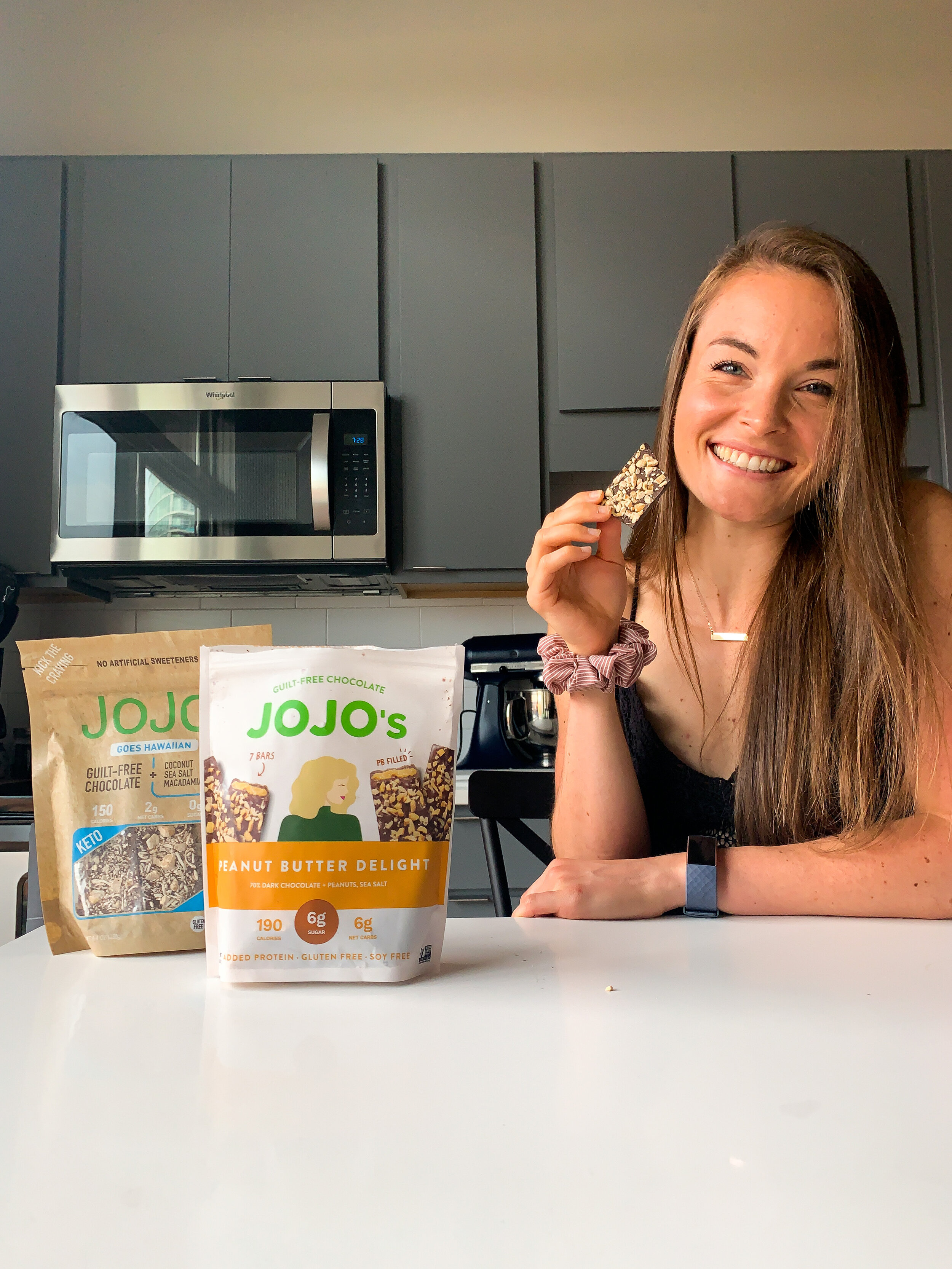This post contains an affiliate link from which I may earn a small compensation. All statements are my own - I love and support JOJO’s Chocolate, and want to say thank you for supporting my blog in return!
“You can’t buy happiness, but you can buy chocolate, and that’s pretty much the same thing.”
Yes, yes it certainly is.
During one of my visits home in college, as I peeked into the pantry to see what snacks Mom and Dad had gathered since my last visit, Mom insisted I try some of this new chocolate she’d found. On the resealable bag stamped boldly with “JOJO’s” were the claims “kick the craving!”, “low-sugar, high-protein” and I rolled my eyes. Will it even taste good? Can’t I just satisfy the craving rather than “kick” it? I questioned, but I bit into a bar studded with crunchy, salty pistachios and tart dried cranberries anyway (I’ll never turn down free dark chocolate).
It was creamy and rich, just like chocolate should be. It was sweet enough to satisfy the sugar craving without overwhelming your taste buds with pure sugar. Actually, JOJO’s doesn’t even add sugar to their chocolate - instead, they sweeten it with stevia. I know, I know - you’re imagining that unpleasant aftertaste it leaves on your tongue. I hate it, too, which is why I avoid stevia and was skeptical about it in this chocolate. Trust me, though, when I say the stevia flavor is as undetectable as the spinach flavor in a fruit smoothie!
Now on an almost-daily JOJO’s Chocolate kick, my favorite is the Peanut Butter Delight, with the Raspberry Dream following closely behind.
Who is JOJO, and what’s so good about her chocolate?
JOJO’s story is pretty amazing. A breast cancer diagnosis and bout of treatment led this mother to realize that, in order to live a longer and healthier life with her family, she needed to make some changes. Beginning with her diet, she felt the need to find healthier alternatives for her sweets cravings - specifically, chocolate. She spent some time in the kitchen coming up with a homemade chocolate recipe so that she could control the ingredients and amounts of each to satisfy her cravings and bring nutritional benefits. Her son, Sterling, came alongside her - he needed something sweet, too - and helped her adapt the chocolate recipe to fit his paleo lifestyle.
These rich, creamy, bittersweet bars are the final product of their hard work, and they’re low in sugar, high in protein, and packed with antioxidants. And, of course, I had to do my research so that I provide evidence behind these claims we so often see on food labels. If chocolate is going to claim to be healthy (and delicious), I’m going to need to see the facts.
So, healthy chocolate, huh? Here’s the research!
Flavanols
Maybe you’ve heard it before - chocolate is a rich source of antioxidants. Specifically, a group of antioxidants called “flavanols” found in cocoa butter acts to neutralize free radicals throughout the body and help prevent oxidative stress, which has been linked to inflammatory and ischemic diseases, hypertension, neurological disorders, and many other negative outcomes (1). Regular consumption of flavanols has been shown to reduce blood pressure (2) and some metabolic markers, such as total cholesterol, LDL cholesterol, blood triglycerides, and blood glucose levels (3). For my grandma’s benefit (the biggest chocolate fan I’ve ever known), the good news is that these flavanols have been shown to improve cognitive function in elderly populations (1).
Stearic Acid
If you’re wondering, “uh… what?” let me explain. Stearic acid is a specific type of fatty acid - a long-chain saturated fatty acid found in both animal and vegetable fats, and it is one of the three fatty acids found in cocoa butter (oleic and palmitic acid being the other two). Unlike other saturated fats, however, stearic acid has been shown to exhibit no effect on cholesterol levels (5, 6). Though it is still a saturated fat that, in cocoa butter lives next to two other saturated fats that do affect cholesterol levels, since stearic acid makes up one third of the fat composition of cocoa butter, it’s nice to know that at least that amount is beneficial for our bodies.
Complete Protein
This isn’t necessarily a snack I’d call “high-protein”, but compared to other chocolate bars, this one definitely takes the gold for protein content. JOJO added hemp protein to her recipe, which on its own, is a plant-based and therefore incomplete protein, but along with the generous sprinkling of crunchy, salty nuts on top of each bar, JOJO made these bars a source of complete protein.
Proteins are made up of small building blocks called amino acids. Of the 20 total amino acids, 9 of them are essential - meaning our bodies cannot synthesize them, so we must consume them in foods or supplements in order for our bodies to meet daily protein requirements (7). Animal sources of protein, like meat, dairy, and eggs, are typically referred to as higher quality because they contain all 9 essential amino acids, while plant-based sources of protein contain less than all 9 and are therefore lower quality proteins. Don’t let this stop you from consuming more plant-based proteins! By combining multiple plant-based protein sources, the body can obtain all 9 essential amino acids to carry out metabolic needs and help stimulate muscle growth (8).
Low Sugar
The high-protein and low-sugar content work together to satisfy chocolate cravings without the negative side effects of a super sweet snack. In a study investigating the effect of a high protein diet for 5 weeks (30% protein, 30% fat, 40% carbohydrate) on the blood glucose levels of those with type 2 diabetes, researchers found that the increase in protein paired with the slight reduction in carbohydrates (compared to a diet recommended for the general population composed of 15% protein, 30% fat, and 55% carbohydrate) did result in a small but significant reduction in blood glucose levels (3). Given that JOJO’s Chocolate also leaves the sugar out of the equation, the common spike and crash in blood sugar levels after consuming a sweet snack is not a concern here.
Where can you get your hands on some JOJO’s?
Head over to the JOJO’s Chocolate online shop and be sure to use the code “HUNGRYHALEY10” for 10% off your purchase!
References:
Lobo, V., Patil, A., Phatak, A., & Chandra, N. (2010). Free radicals, antioxidants and functional foods: Impact on human health. Pharmacognosy Reviews, 4(8), 118. doi:10.4103/0973-7847.70902
Hooper, L., Kay, C., Abdelhamid, A., Kroon, P. A., Cohn, J. S., Rimm, E. B., & Cassidy, A. (2012). Effects of chocolate, cocoa, and flavan-3-ols on cardiovascular health: A systematic review and meta-analysis of randomized trials. The American Journal of Clinical Nutrition, 95(3), 740-751. doi:10.3945/ajcn.111.023457
Desideri, G., Kwik-Uribe, C., Grassi, D., Necozione, S., Ghiadoni, L., Mastroiacovo, D., . . . Ferri, C. (2012). Benefits in Cognitive Function, Blood Pressure, and Insulin Resistance Through Cocoa Flavanol Consumption in Elderly Subjects With Mild Cognitive Impairment. Hypertension, 60(3), 794-801. doi:10.1161/hypertensionaha.112.193060
Mastroiacovo, D., Kwik-Uribe, C., Grassi, D., Necozione, S., Raffaele, A., Pistacchio, L., . . . Desideri, G. (2014). Cocoa flavanol consumption improves cognitive function, blood pressure control, and metabolic profile in elderly subjects: The Cocoa, Cognition, and Aging (CoCoA) Study—a randomized controlled trial. The American Journal of Clinical Nutrition, 101(3), 538-548. doi:10.3945/ajcn.114.092189
Hunter, J. E., Zhang, J., & Kris-Etherton, P. M. (2010). Cardiovascular disease risk of dietary stearic acid compared with trans, other saturated, and unsaturated fatty acids: A systematic review. The American Journal of Clinical Nutrition, 91(1), 46-63. Retrieved June 02, 2020, from https://academic.oup.com/ajcn/article/91/1/46/4597175.
Denke, M. A. (1994, December 1). Effects of Cocoa Butter on Serum Lipids in Humans: Historical Highlights. Retrieved June 02, 2020, from https://pubmed.ncbi.nlm.nih.gov/7977142/
Recommended dietary allowances (10th ed.). (1999). Washington DC: National Academy Press.
Berrazaga, I., Micard, V., Gueugneau, M., & Walrand, S. (2019). The Role of the Anabolic Properties of Plant- versus Animal-Based Protein Sources in Supporting Muscle Mass Maintenance: A Critical Review. Nutrients, 11(8), 1825. doi:10.3390/nu11081825
Gannon, M. C., Nuttall, F. Q., Saeed, A., Jordan, K., & Hoover, H. (2003). An increase in dietary protein improves the blood glucose response in persons with type 2 diabetes. The American Journal of Clinical Nutrition, 78(4), 734-741. doi:10.1093/ajcn/78.4.734




